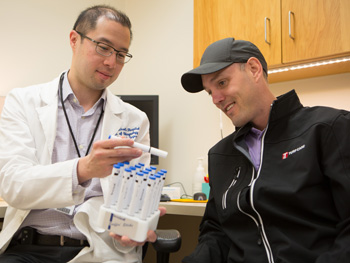Non-invasive test could be a marker for healthier sinuses

By Greg Winson

Dr. John Lee explains the Sniffin’ Sticks test to patient Jeremy Phillips in the Sinus and Nasal Physiology Lab.
(Photo by Katie Cooper)
Chronic sinusitis is an inflammatory disease that affects
five per cent of Canadians. Patients can feel like they have
a cold for months on end.
One of the challenges for physicians treating sinusitis is
selecting the best treatment. Some patients respond well
to nasal sprays or antibiotics, while others require surgery
for relief. Nitric oxide may provide the answer.
“Nitric oxide is a gas normally produced by our sinuses,”
explained Dr. John Lee, an otolaryngologist-head and
neck surgeon and director of the Sinus and Nasal
Physiology Lab at St. Michael’s Hospital. “It’s there to
help fight bacteria and viruses in our sinuses.”
A study by Dr. Lee, with colleagues in the Division of
Respirology, show that nasal nitric oxide levels may be a
biomarker for sinusitis. Healthy sinuses have higher nitric
oxide levels than patients with evidence of inflammation
or infection. The non-invasive test that measures nitric
oxide takes just 20 minutes to perform.
Research performed at the Sinus and Nasal Physiology
Lab, the only lab of its kind in the Greater Toronto Area,
informs patient care and treatment.
“The more we are able to objectively know what’s going on in the sinuses, the better we can tailor the appropriate
treatment,” said Dr. Lee.
Did you know? Nitric oxide was named |
St. Michael’s was one of the first hospitals to have a nasal airflow
laboratory. In the 1980s, otolaryngologist Dr. Philip Cole designed
the first airflow measurement that in its time was a standard for
measuring airflow and resistance through the nose.
When Dr. Lee arrived at St. Michael’s in 2009, he set about
reviving the lab using newer, non-invasive devices to provide a
comprehensive assessment of sinus and nasal function.
In addition to airflow, the Sinus and Nasal Physiology Lab
also assesses patients who complain of a lack of smell. The lab
performs a test with 16 common scents in the form of
Sniffin’ Sticks that can objectively measure smell function.
About St. Michael’s Hospital
St. Michael’s Hospital provides compassionate care to all who enter its doors. The hospital also provides outstanding medical education to future health care professionals in more than 29 academic disciplines. Critical care and trauma, heart disease, neurosurgery, diabetes, cancer care, care of the homeless and global health are among the Hospital’s recognized areas of expertise. Through the Keenan Research Centre and the Li Ka Shing International Healthcare Education Centre, which make up the Li Ka Shing Knowledge Institute, research and education at St. Michael’s Hospital are recognized and make an impact around the world. Founded in 1892, the hospital is fully affiliated with the University of Toronto.
